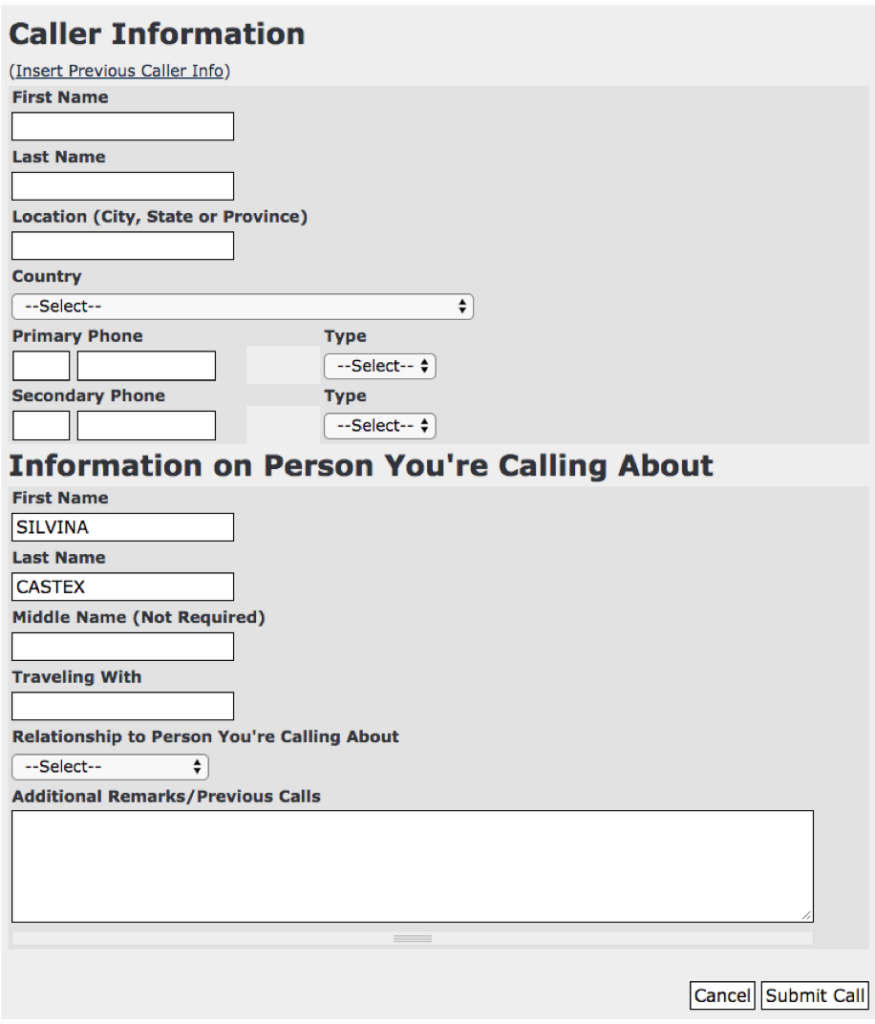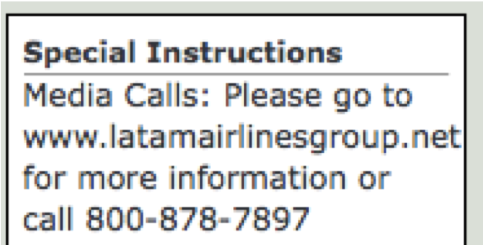3. Pasos Básicos de Una Llamada
Los procedimientos que utilizará para manejar las llamadas se encuentran a continuación.
Recuerde que el guión siempre tendrá el vocabulario adecuado que debe utilizar.

- Siempre conteste la llamada dando su nombre y apellido y confirme que la persona está llamando sobre este incidente específico.
- Siempre pregunte a la persona si está llamando a una persona específica, ya que la persona que llama podría ser de los medios de comunicación.
- Termine la llamada con amabilidad y rapidez si la persona que llama no está llamando por la crisis. (Siempre siga el guión).
- Si es necesario, haga preguntas clave para determinar si la persona que llama es un miembro legítimo de la familia.
- Proporcione información de crisis a familiares y amigos.
- Reúna información básica sobre la persona que llama (más información sobre esto en la siguiente diapositiva).
- Finalice la llamada lo antes posible para poder contestar otras llamadas en espera.
Este curso le proporciona la instrucción adecuada para cada uno de estos procedimientos.
Responder la llamada
Al contestar la llamada, tiene que darle rápidamente a la persona que llama el Nombre del Incidente como parte del saludo, para que pueda terminar la llamada lo más rápido posible si su ser querido no está involucrado.
Debe proporcionar información sobre el incidente después de buscar los nombres de los seres queridos y recopilar la información de la persona que llama. Sin embargo, si la persona que llama insiste en tener información de inmediato o suena muy molesta / preocupada, se le puede proporcionar información sobre el incidente si la solicita para evitar más frustración.
Por ejemplo, si el cliente es Universal Airways y el vuelo involucrado en el accidente es el vuelo 1212, la secuencia de comandos puede leer lo siguiente:
“Hola, mi nombre es Maria Lopez. Ha llamado al Centro de Información para familias y amigos de Universal Airways. ¿Está llamando por alguien que estaba a bordo del vuelo 1212 de Universal Airways?”
Si la respuesta es “SÍ”, debe proceder con llamada.
Si la respuesta es “NO” debe leer lo siguiente:
“Lo siento, pero este número es para familiares que intentan comunicarse para obtener información sobre sus seres queridos y debo terminar esta llamada para permitirles que se comuniquen. Muchas gracias por tu comprensión.”
- Si las personas que llaman preguntan si alguien de la familia llamó por el mismo ser querido, no está permitido revelar esa información. “Me encantaría poder proporcionar más detalles sobre las llamadas anteriores, pero es información confidencial. ¿Podría consultar con su familia si alguien más ha llamado y darles noticias? ”
- Si la persona que llama informa que ha llamado antes, puede acceder a todos sus detalles. No es necesario solicitarlos otra vez. Pero siempre informe a la persona que llama que puede ver todos sus detalles, confírmelo y pregúnteles si desean proporcionar información adicional.
Recopilación de Información Básica
Aunque queremos que las llamadas sean contestadas lo más breve posible, debemos asegurarnos de adquirir información básica para comprender mejor con quién estamos hablando, para que luego podamos comunicarnos con esa persona, si es necesario.
Deletree los nombres que no se entienden bien y siempre confirme/repita los números de teléfono.
La información básica incluye :
- Nombre de la persona que llama.
- Nombre del pasajero por el cual llaman. (en diferentes situaciones, los afectados no serán llamados “pasajeros”. Notificaremos cuando esto sea diferente).
- Número(s) de teléfono donde podemos comunicarnos con la persona que llama durante las próximas horas. (Siempre verifique el número incluyendo código de país)
- La relación de la persona que llama con el pasajero (o persona afectada). Si una madre llama para su hija la relación es Madre. (Preste mucha atención a esto)
- Observaciones adicionales: agregue cualquier información adicional que la persona que llama quiera proporcionar.
- En algunos casos, es posible que algunos clientes deseen recopilar información adicional, como dirección, idioma, etc. Proporcionaremos a todos los agentes una plantilla con todos los campos obligatorios y la información que se necesita.

You should give the Incident / Crisis Information after searching for the loved one’s name and gathering the Caller’s contact details.

When someone (the caller) is confronted with overwhelming fear of serious injury or death of a loved one, their logical thinking is no longer dominant, as it is in a normal situation. The emotional thinking takes over, so when they hear information about the crisis, they are not able to hear / process that information, logically.
Callers need to first connect with someone who can reassure them that they can help and so when the agent takes the caller information for a call back, the agent creates a connection with the caller and the worried family member starts feeling that someone is there to help. Only after establishing that connection, will the caller be able to hear and understand the information about the crisis where their loved ones might be involved.

Passenger Manifest
When an accident occurs, many of our clients will provide us with a manifest, or list, of passengers or guests on the plane, ship, train, etc. For various reasons, it might take the company some time to obtain this list. Once they have the manifest/list, they will then send it to us to upload into CS2.

Your actions will be slightly different depending on whether or not we have a passenger list when you begin taking calls.
Don’t worry, your script will guide you as to what you will need to say.
When No Manifest is Available

If there is no manifest, you will:
- Offer the caller any Crisis Information, located on the left of the CS2 screen (This will be updated live if any changes occur).
- Collect caller’s information using CS2’s “Caller Information” form (you will learn more about this soon)
- Advise the caller that a member of your team or the Family Support Center will call the family back only if the person they are inquiring about has ben affected by the accident.
Due to the thousands of calls that may come in, it’s impossible to call everyone back, particularly when their loved one was not affected. So, we never want to make false promises.
When a Manifest is Available

When we do have the passenger manifest, you will be able to “qualify” callers as follows:
- You will ask the caller the name of the person they are inquiring about (spell back the names not easy to understand)
- If the name the caller provides is ON the manifest, it will appear in your list of search results. (Do not inform that the name is a MATCH, or is on the list, at this point) You will then inform the caller that you will need to collect basic information and enter them in the “Caller Information” form in CS2. If there are similar names, and/or if you are not sure whether it’s a match or not, you will still collect the caller’s info.
- If the name the caller provides does not match a name in your search results, you will advise the caller the name is not on the list. You will ask the caller if they want to try a different name, collect the caller information if they insist the loved one should have been onboard, or end the call if they are confident that the loved one was not involved as the names was not found. You will be provided with exact scripting for ending each call. Follow the script accordingly.

If a caller asks for a name that does not come up on the search result as the name is not on the first list as it, but the agent takes all details because the caller insists, the name of the passenger will be saved and shown on the Search Results with three stars ***. If someone else calls back and asks for the same person, the next agent will see the name with*** asterisk but WILL NOT confirm that the person is on the manifest, as agents know that names with *** were entered manually by another agent on a previous call.
Types of calls
In the list below you will see examples of the kinds of subjects you may experience in your interaction with callers.
- Name of loved one is on the list
- Name of loved one is not on the list and caller hangs up
- Name of loved one is not on the list but caller insists to give all detail
- Media Call

Most People Are Understanding
Most people will understand the critical nature of the moment and end the call. However, you may get someone, or even people in the media, who may insist in asking other questions. You should always be courteous but, if necessary, you may terminate the call.
As a general rule, You will only provide Special Instructions to media callers, however if the media caller insists on getting information, you can provide Crisis Information as that is already public.
Always check the “Special Instructions” box to the bottom
left of your screen for information on handling media calls.

Remember that your interaction with callers is in the very early stages following an accident.
When you do speak with friends or family members, many will be stunned and in some form of shock or in denial.
Be prepared to sometimes repeat your questions in order to obtain needed information.
At times of crisis, it is imperative that you use a calm, low—pitched voice when speaking to family members. Compassion is key, treating the callers as you would wish to be treated if you were in their shoes, worried about your loved one and desperate for information.
Survivor Interview – Video clip
Scott Maurer is a family survivor who lost his daughter, Lorin, 30 years of age, on Continental Air/Continental Flight 3407 on February 12, 2009. Scott shares the story of how he & his wife, Terry, had such a difficult time getting information from the airline after the accident. Kevin, referenced in the video, was Lorin’s boyfriend who was awaiting her arrival in Buffalo, New York. The video in the next slide is an example on how important it is for family members of loved ones involved in the disaster to be able to quickly obtain information and feel and emotional connection to those working for (or on behalf of,) the company, such as yourself.
A quick recap
Let’s do a quick review:
- Call handling procedures vary slightly depending upon whether we have the passenger manifest (list).
- Your script will prompt you to provide the caller with the incident information.
- We qualify callers to process calls as quickly as possible. For qualified callers, you will collect basic information from the caller.
- If we do not have the manifest, you will advise callers that a member of your team or the Family Support Center will call back IF it has been determined that the person they are inquiring about has been affected by the incident.
- When we do have a manifest, you will first check to see if the name of their loved one is a match in CS2, then proceed with your script on your screen.
- Use a compassionate tone at all times.
